Space Shuttle Launch Complex 39-B Construction Photos
Page 9
Payload Canister First Fit Check
(Original Scan)
Payload Canister, first lift. Fit check, test of the 90 ton hoist, and just a general rehearsal of things, looking to see if there are any hidden problems or peculiarities. That vehicle which carries the Canister out to the pad was a really weird critter, and had about a million wheels. Bottom right image is Jack Petty, who took my picture as I stood on the Lightning Mast, and who shared the deranged misadventure with me at A Pad. Jack was the tech rep for BRPH, who were the NASA-side architects and engineers that watched over the construction effort we were involved with on the pad. Jack was a rough tough ex-ironworker with a heart of gold. But don't tell him I said that, 'cause he'd hate it if you did.
Additional commentary below the image.
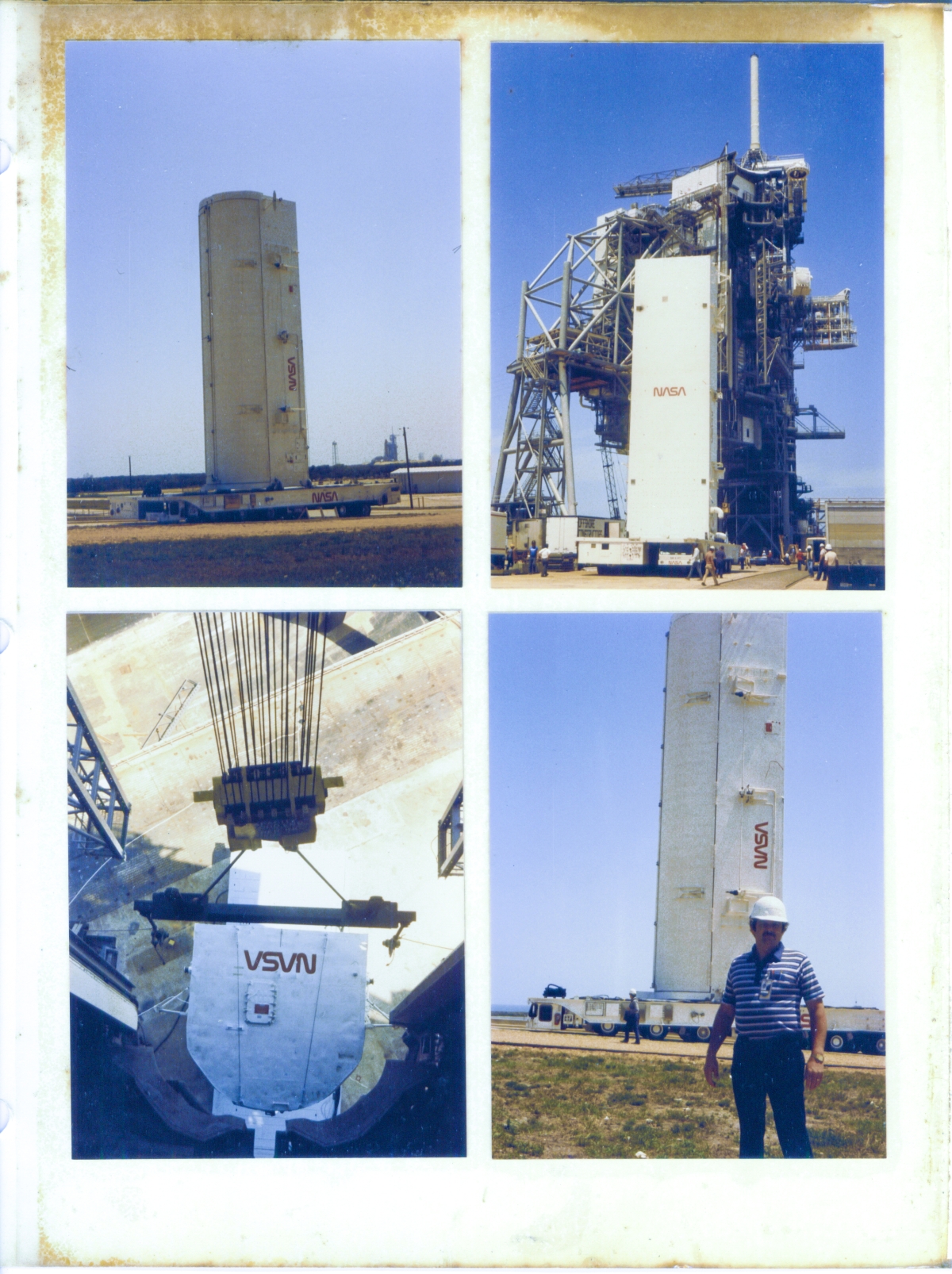
Top Left: (Full-size)
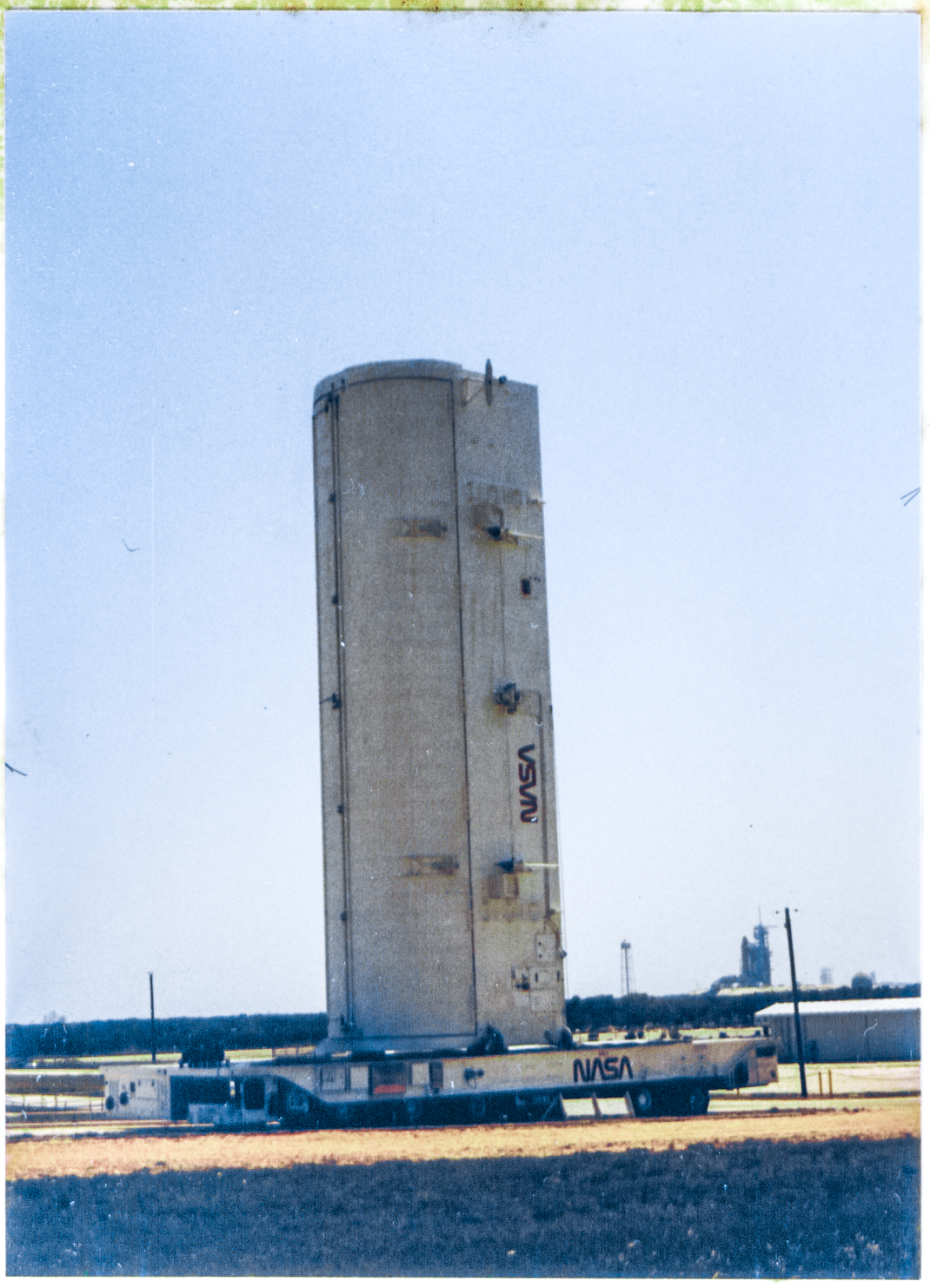
This is the Payload Canister rolling ever-so-slowly up the pad slope on its transporter, and this is the last leg of a cross-country journey of almost 10 miles, which is how encapsulated payloads were taken from the O&C Building, or perhaps the VPH, out to the pad deck, to then be lifted into place against the face of the RSS, and extracted from the canister by the PGHM, to then be placed on board the Space Shuttle after the canister had been lowered and removed, and the orbiter had been rolled out to the pad.
The payload canister was filled up in the O&C Building or elsewhere (and for a bit more insight into one of those elsewheres, you can go here, for lots and lots of words on yet another structural steel construction project I was involved with at one time) with whatever it was that they were going to fly into space, sealed up tight as a drum, and then placed on this thing with a zillion wheels, that could turn completely around, if memory serves, within its own length, (Memory served well. I found a reference document which includes information regarding the Payload Canister Transporter).
-
Quote:
Payload Canister Transporter The payload canister transporter (fig. 6-13) is a
48-wheel self-propelled truck designed to
operate between and within Shuttle payload
processing facilities. It will be used to transport
the payload canister and its associated hardware
throughout KSC.
The transporter is 19.8 meters (65 feet) long and
7 meters (23 feet) wide. Its elevating flatbed has a
height of 1.8 meters (6 feet) but can be lowered to
1.6 meters (5 feet 3 inches) or raised to 2.1
meters (7 feet) ±7.6 centimeters (3 inches). Its
wheels are independently steerable and permit
the transporter to move forward, backward, or
sideways; to "crab" diagonally; or to turn on its
own axis like a carousel. It has self-contained
braking and stabilization jacking systems.
The transporter is driven by a hydraulic system
powered by a liquid-cooled diesel engine
between facilities and by an electric motor using
ground power inside the facilities.
The bare transporter weighs 63 500 kilograms
(140 000 pounds). With a full load of diesel fuel
and with the environmental control system, fluid
and gas services, electrical power system, and
instrumentation and communication system
modules mounted on it, the transporter has a
gross weight of 77 300 kilograms (170 500
pounds).
The transporter is steerable from
diagonally
opposed operator cabs on each end. Its top
speed unloaded is 16 km/h (10 mph). The
maximum speed of the fully loaded transporter is
8 km/h (5 mph). Because payload handling will
require precise movements, the transporter has a
"creep mode" that permits it to move as slowly as
0.64 cm/s (0.25 in/s) or 0.023 km/h (0.014 mph).
Interfacility drive power is provided by a 298-
kilowatt, (400-horsepower) diesel engine.
Intrafacility drive power comes from an 82-
kilowatt (11 O-horsepower) electric motor. The
transporter will carry the payload canister in
either the horizontal or vertical position.
Close quote.
-
And it had a suspension for all those wheels that had to be seen in action to be believed. Whatever the hell it was going across, no matter what its slope was, the top of it would remain perfectly level.
And so, extra-tall and tippy things like the payload canister could be placed on top of it without worrying that they would tip over, and get rolled cross-country, up the pad slope and underneath the RSS, where it would sit with the canister on top of it, while they rigged the canister.
It moved very slowly.
Zoom in on the image, and you can see the cab the driver sits in, kind of indistinct in shadow, on the front left corner, complete with door and windshield.
We always got a kick out of seeing that thing, wherever it was that they may have been driving it around, 'cause it was just so goddamned weird.
This was the first functional test of the whole payload canister system as it related to Pad B, and it was a pretty big deal.
Our RSS had to be right, or otherwise, no canister for you, Mister Space Shuttle.
Handling the payload canister was the primary reason for building the RSS in the first place, so on this day, we had arrived in some serious Truth or Consequences territory, and everybody wanted this sonofabitch to work, which it did.
Off in the distance, in the background, Pad A can be seen, and there's an orbiter on the pad and the RSS is mated to it. I do not recall which orbiter it was, alas.
To the right of A Pad, just past the power pole near the foot of the pad slope, a gray rectangular structure can be seen in the far distance between that pole and the dark round ball of the A Pad lox tank. That's Pad 41, and it's where I went after we handed B Pad over to NASA. Lot of fun and games there, too, but no pics. That's Air Force territory over there, and they were much less inclined to permit any shenanigans with a camera than NASA was. But holy shit some of what went down on the tear-out and refurb of Pad 41 just simply defies belief. Those guys started out with what turned out to be a very bad premise, and by the time everybody realized it, it was way WAY too late, and all parties concerned just had to sort of grit their teeth and keep on grinding forward, and it was a goddamned nightmare, but somehow, in the end, we got the damned thing done on time. The budget, however, was not so fortunate, and I was Change Order King over there for the better part of five years. Yeeks!
Top Right: (Full-size)
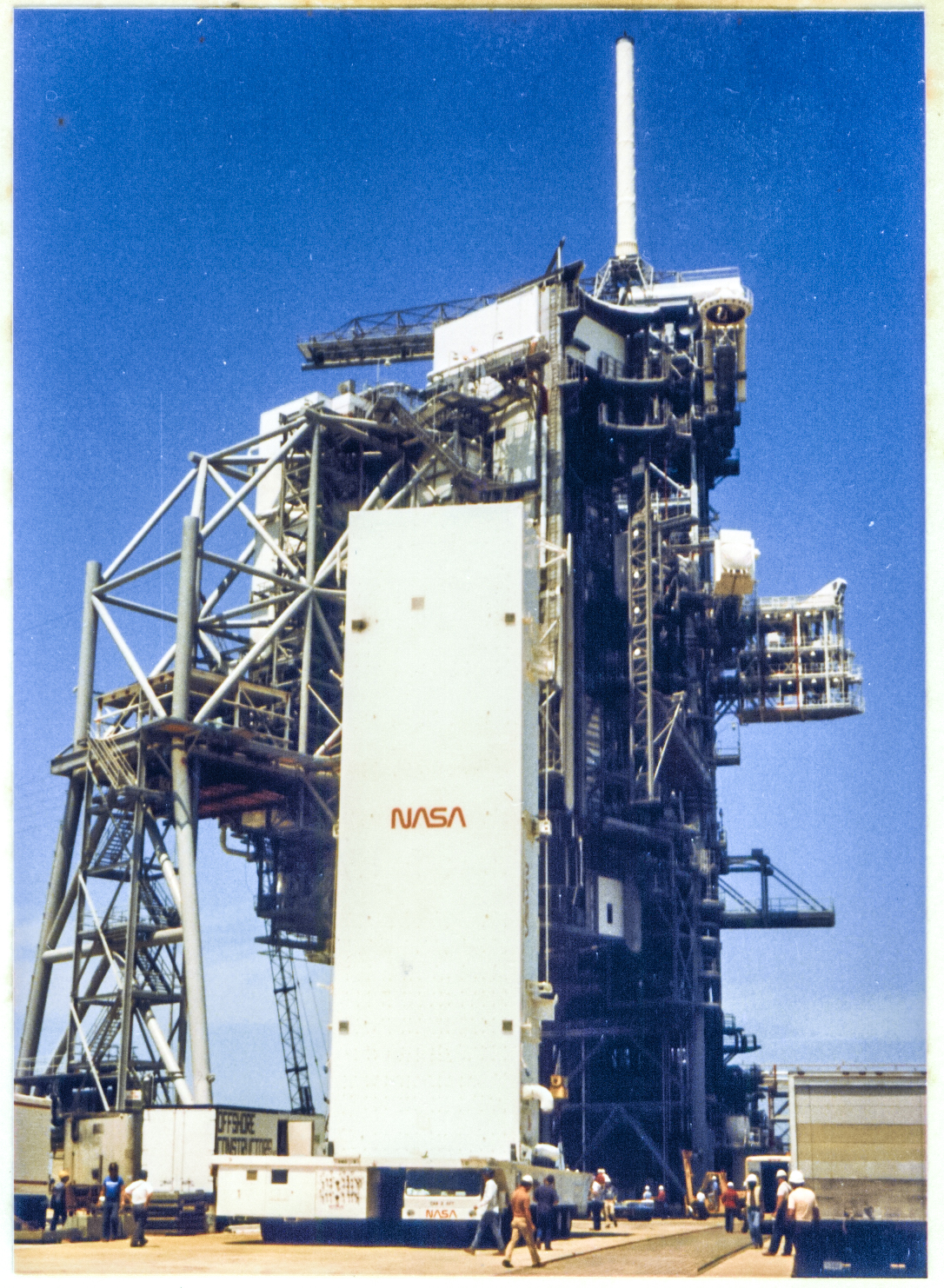
Ok, here we are, up on top of the pad deck. This event occurred fairly late in my tenure out there, as can be seen by giving the RSS a good look, where you can see all of the swing arms (Gox Arm, Orbiter Access Arm, and Intertank Access Arm) already installed on the tower, as well as the Centaur Porch, which has not yet had the RBUS installed on it yet. So we're fairly late in the game, but not to the end of things, quite yet.
Pretty good attendance this day, as can be seen by all the people sprinkled around in the picture.
Note that we're now looking at the "back" side of the canister transporter, and it's got a driver's cab back there, too. In truth, the thing did not have a front side or a back side. Didn't matter which way it was pointed. Driver gets in and "go." Real simple that way.
This shot gives you a pretty good sense of scale for the size of the payload canister, which was about sixty some-odd feet tall. And remember, pretty please, all the large-scale stuff that fits inside of the canister, will eventually be placed inside the Space Shuttle. That goddamned Space Shuttle was big.
Bottom Left: (Full-size)
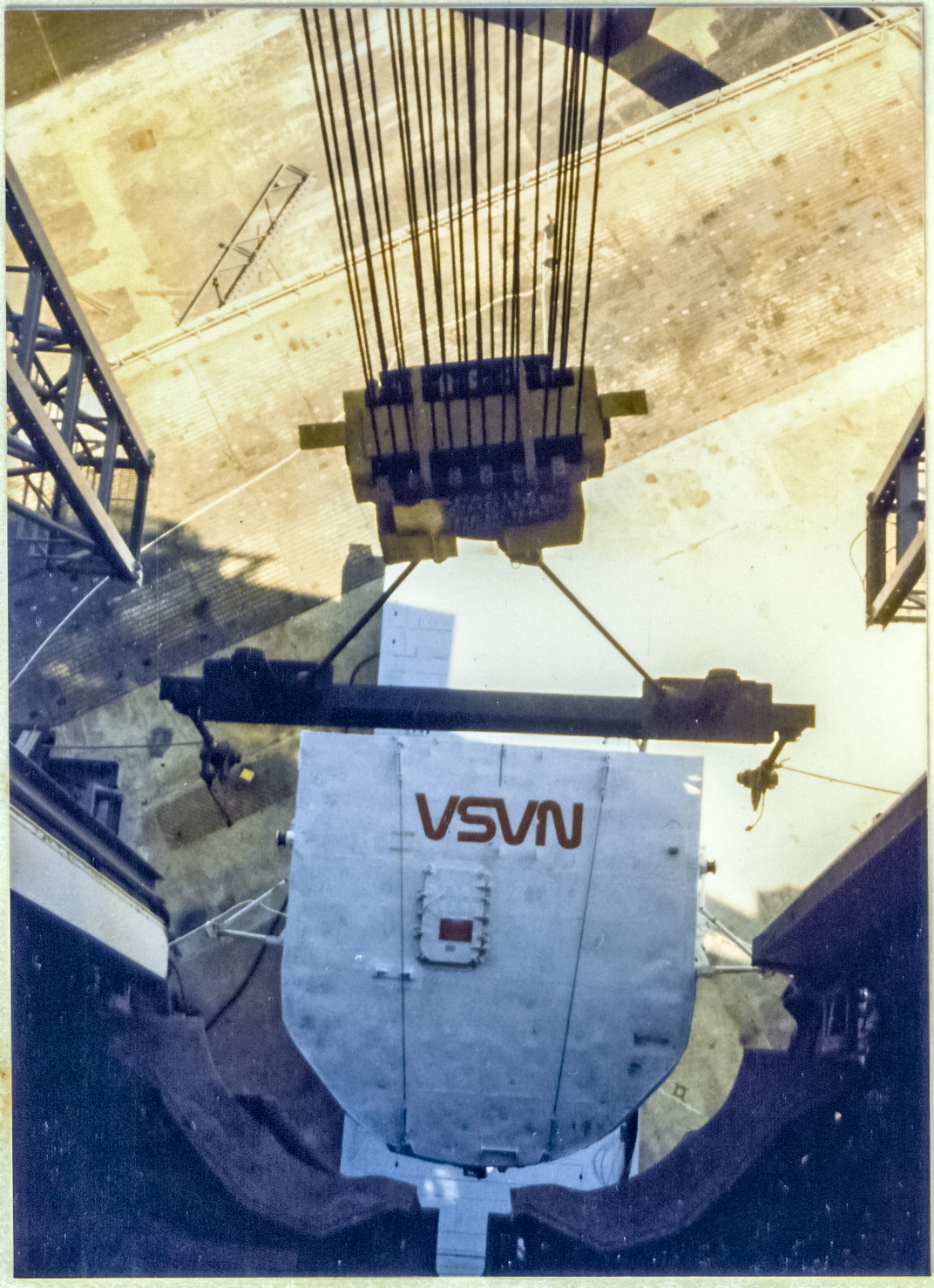
And now I've moved up on to the RSS, from what appears to be the main framing elevation inside the RCS Room, but might also be the platform just beneath the RCS Room on the front of the RSS that gave access to the rolling ladder which itself gave access to the orbiter's cockpit windows. We're looking pretty much straight down, and it's about 150 feet down to the pad deck from here. Beneath you, the dark silhouette of the PCR Floor and the slightly-lighter top of the OMS Pod heated purge covers delineates the orbiter mold line at the 135' level, with its pair of roundy-looking cutouts for the OMS Pods, as well as the notch between them for the tail of the orbiter, which can be seen clearly. On either side of the 90-ton Hoist's lifting block, extending in from both edges of the image, the framing for the very bottom ends of both the left and the right ET Access Platform Guide Columns can also be seen. There was no orbiter at the pad this day, so the Guide Columns were in their lowered position. Had there been a Shuttle involved, the Guide Columns would have been lifted up out of the way, locked into their retracted position, and unseeably out of frame in this view.
You're getting a pretty good view of the lifting block on the 90-ton Payload Hoist, supported by its 24-part line, along with the spreader-beam below it with its wire-rope lifting pendants that will attach to the two lifting points that stick out as little stubs on either side of the canister, which you can see on a line more or less even with the near-side edge of the "NASA" lettering on the canister. That spreader beam is a bit complicated-looking because it has a another pair of attach points that will be connected to the fixed boom pendants that hang down from up inside of the top of the RCS Room. We'll see pictures of them later on here, and they were pretty damn stout, as far as wire-rope fittings go. Once the canister had been lifted into place by the hoist, those pendants would get attached, the hoist would be let down just a bit until the pendants were taking the full load of the canister's weight, and then the hoist would be taken loose, with its 24-part-line business-end lifted up and out of the way, whereupon the canister, and everything in it, would be in suspension, supported solely by those pendants. We furnished that stuff, and it was a Big Deal, and it all got the living hell proof-tested out of it, and all the wire rope and swaged ends and all the rest of it had about a full bookshelf's worth of certification paper before it was all said and done, and yeah, I was the one who's job it was to make damn good and sure that all of the proper copies had been submitted and approved, and then other copies kept in our field trailer, and then even more copies delivered to various parties from our prime contractor all the way up to NASA itself, and all points in between, and everybody was quite excited about every last bit of it on account of the potential for a severely catastrophic event should one of those pendants, god forbid, ever decide to fail.
The two small triangular-looking "antenna" kind of things on either side of the canister, up near its very top, weren't antennas at all, but instead they were the supports for the canister "guide shoes" and they can be seen in a couple of the other images on this page. Each guide shoe had a Teflon-faced little (well, it wasn't really little at all, but you know what I mean) "skid" on it, and these "skids" would need to match up perfectly with a pair of "guide rails" which were nothing more than a couple of well-aligned I-beams, one of which can be seen clearly just outboard of the white surface of the left-hand Orbiter Side Seal Panel, which has been retracted (inward, in toward the body of the RSS, from its vertical hinge-line which is more or less flush up against that guide rail) out of the way. The other guide rail is hidden behind the right side-seal panel which was welded in place, rotated 90 degrees outward into the extended position, after they determined that they couldn't hit the orbiter with it even if they'd tried to, as I discussed on the previous page. This whole system, shoes and rails, had to be dead nuts or otherwise the canister might bind on the rails while being lifted or lowered, or perhaps wind up in some god-awful wrong place, and some of this stuff is just mind-numbingly unforgiving and it's all gotta be just fucking right and it all trundles around with a fifteen-story high-rise tower that's slung sixty feet up into the goddamned air, and holy shit but you cannot imagine how all this shit has to fit together and work perfectly, despite the fact that it's bigger than most ships, and not one single bit of that psychosis can be seen, determined, or discovered, by merely looking at things. Nothing stays put. Nothing sits tight. It's all over the goddamned place, all the goddamned time, and it has to fit together like the innards of a spring-powered wristwatch, every single time somebody rolls, moves, flips, rotates, latches, unlatches, slides, extends, retracts, mates, de-mates, or otherwise puts into motion, ANY of it. And yet it all works perfectly, every time.
I rant and rave about how fucked-up things were so often that you might draw the wrong conclusion from it. So I will stop here and now, and tip my hat to every last one of the people who were involved in designing, fabricating, installing, testing and using this stuff. It is, all of it, a fucking miracle. It is, all of it, just fucking miraculous.
Watching high-end work being done, and then seeing the results of that high-end work in action, is one of the most satisfying and pleasurable things you'll ever encounter in the world, although it does tend to give you a progressively dimmer and dimmer view of all those slackers, social-climbers, goof-offs, bullshitters, back-stabbers, money-grubbers, half-laugh lie-smilers, and other lower life forms that you find yourself having to put up with elsewhere in your life. Fuck those idiots. I know it can be done better. I've seen it done better. I've done it better myself. So how 'bout you just knock it off with your bullshit, right now, Fuckworthy, and get your ass in gear and get it done.
Bottom Right: (Full-size)
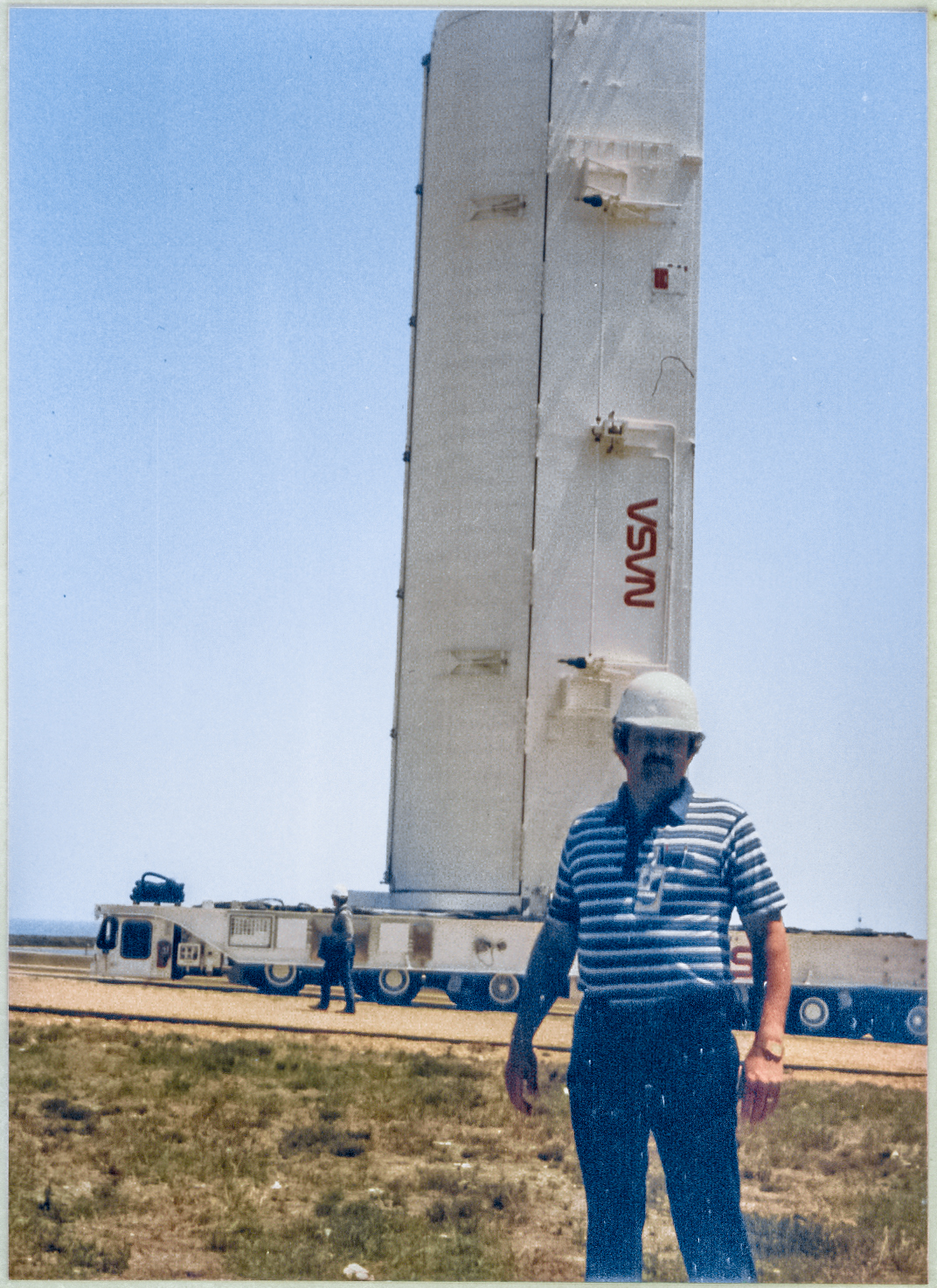
Jack Petty. Tech rep. Ex-ironworker. Another Good Man.
Return to 16streets.comACRONYMS LOOK-UP PAGEMaybe try to email me? |